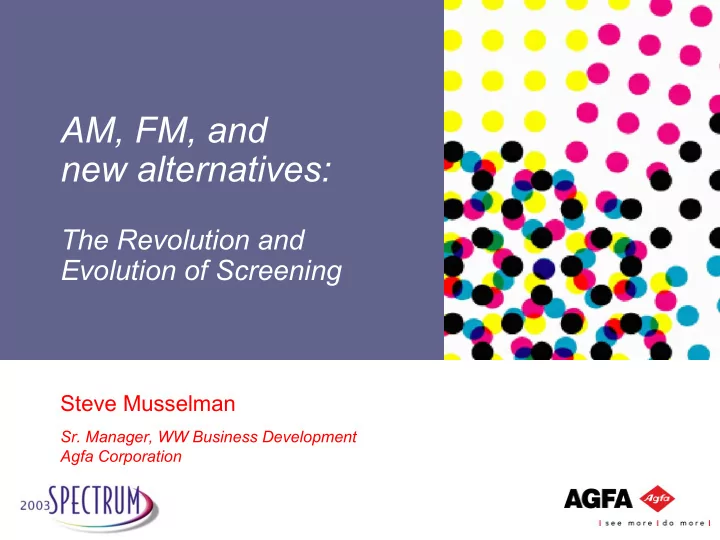

AM, FM, and new alternatives: The Revolution and Evolution of Screening Steve Musselman Sr. Manager, WW Business Development Agfa Corporation
Screening dates back to the origins of photography � 1852 William Henry Fox Talbot � patents photo-etching � uses a woven cloth screen to modulate tones of photographs. � 1881 Frederick Ives � 1882 Georg Meisenbach � 1890 Max and Louis Levy � 1890s Max Perlmutter Early FM Screening?
100 years later…the FM Revolution 1993: � The advent of Frequency Modulation. Agfa’s CristalRaster � 1994 GATF InterTech award � Linotype-Hell’s � Diamond screening
And, the Computer-to-Plate Revolution � 1990: Advent of the “digital plate”. � N90 photopolymer plate; variant of “projection plates” � 1994: Advent of Computer-to-Plate. � Optronics, Gerber & Creo CTP products 1st to market � Now, in 2003, there are over 16,000 CTP systems installed world-wide.
With CTP, AM screening has reached its limit. � Amplitude Modulation: � Highlight and shadow detail can often be lost on press. � Frequency can now exceed engine addressability.
CTP quality can exceed press capabilities. A CTP plate can resolve more than the press can hold. � 10.6 µ line � Top: � Kodak Thermal (Imaged on Creo) � Middle: � Agfa Silver (violet) (Imaged on Galileo) � Bottom: � Agfa Thermal (Imaged on X45) Printed Sheet Plate
FM: fine, consistent dots; “grainy” midtones. � FM implies fixed size, controlled placement to generate tones. � Clustering often occurs in the mid-tones � Some 2 nd order FM create swirls to minimize grain Clustering
1 st and 2 nd order FM screening examples � Press-sheets: � Plates: 2 nd : Luscher 1 st : Agfa 2 nd : Creo
Trade-offs: AM versus FM screening � Each technology has its best fit. 175 lpi AM vs. 21 micronFM AM FM Rendering of fine details - + Smooth flat tones + - Less Inherent Dot gain (TVI) + - Press reponsiveness + - (ability to adjust colours) Reduced Color Moiré - + Reduced Subject Moiré - + HiFi colour separations - + Extended Run length + - Reduced clipping in highlights - + Rendering of midtones + - Open shadow details - +
Hybrid screening – trying to bridge AM & FM � Segmentation method � Specific AM & FM areas � “Classic” Hybrid from Artwork Systems (PCC) � Stochastic distribution of AM dots � “Spekta” from Screen
XM: an alternative to AM, FM & Hybrid � XM = Cross Modulation � A screen that crosses smoothly from AM to FM � Implemented via a single tiling algorithm Patents awarded to Agfa: � 1997 EU, 1998 US � Marketed by Agfa as :Sublima � Similar approach by Artwork Systems (Quantum) � Similar approaches by Esko-Graphics and Creo (SambaFlex & MaxTone for Flexo)
Not stochastic: FM dots at AM angles • Stochastic implies random • Highlight details may look stochastic, but are not. • FM placement along existing AM angles of mid-tones. • XM’s AM-to-FM transition point is line frequency dependent.
FM, XM & Hybrid screens side-by-side. (200x) Agfa CristalRaster 21 µ 1 st order Heidelberg Satin 20 µ 1 st (?) order Creo Staccato 21 µ 2nd order Screen Spekta Random AM 21 µ Agfa Sublima 340 lpi XM screening Fuji 300 lpi CoRes AM Dithered Grey
FM = increased gamut? 300 lpi AM � FM attributes are really small-dot attributes. Microdots are the primary cause of any � measured/perceived gamut increase, rather than how they are organized. 21 µ 1 st order FM 175 lpi AM 340 lpi XM
What’s better: fine AM, XM or FM? � All are good – especially at rendering details. � XM & FM can have the same size minimum dot. � FM screens tend to show noise or grain in flat tints � AM & XM tend to show smoother flat tints � But fine AM can clip (posterize) in highlights 340 lpi XM 21 µ 2nd order FM 21 µ 1 st order FM 300 lpi AM
Take a closer look for yourself… � :Sublima Technology Overview � Printed using only CMYK – no spot colors! � Overall line screen used 340 lpi :Sublima. � Also compares 210, 240 & 280 :Sublima, and shows 21 micron :CristalRaster & 175 ABS.
The FM screening revolution of 1993 has just evolved… AM, FM, XM, Hybrid… the choice is yours. Thank you.
Recommend
More recommend